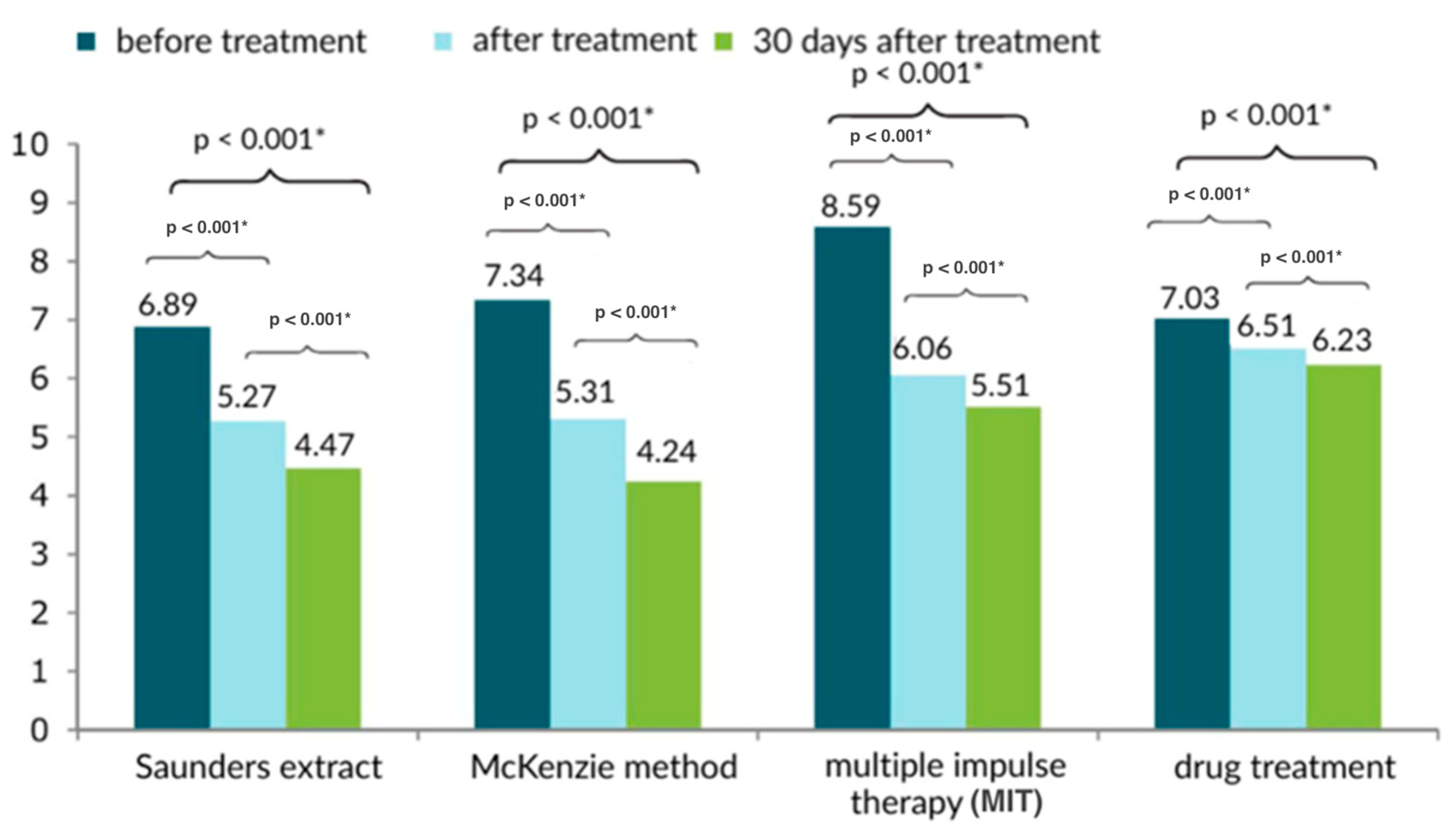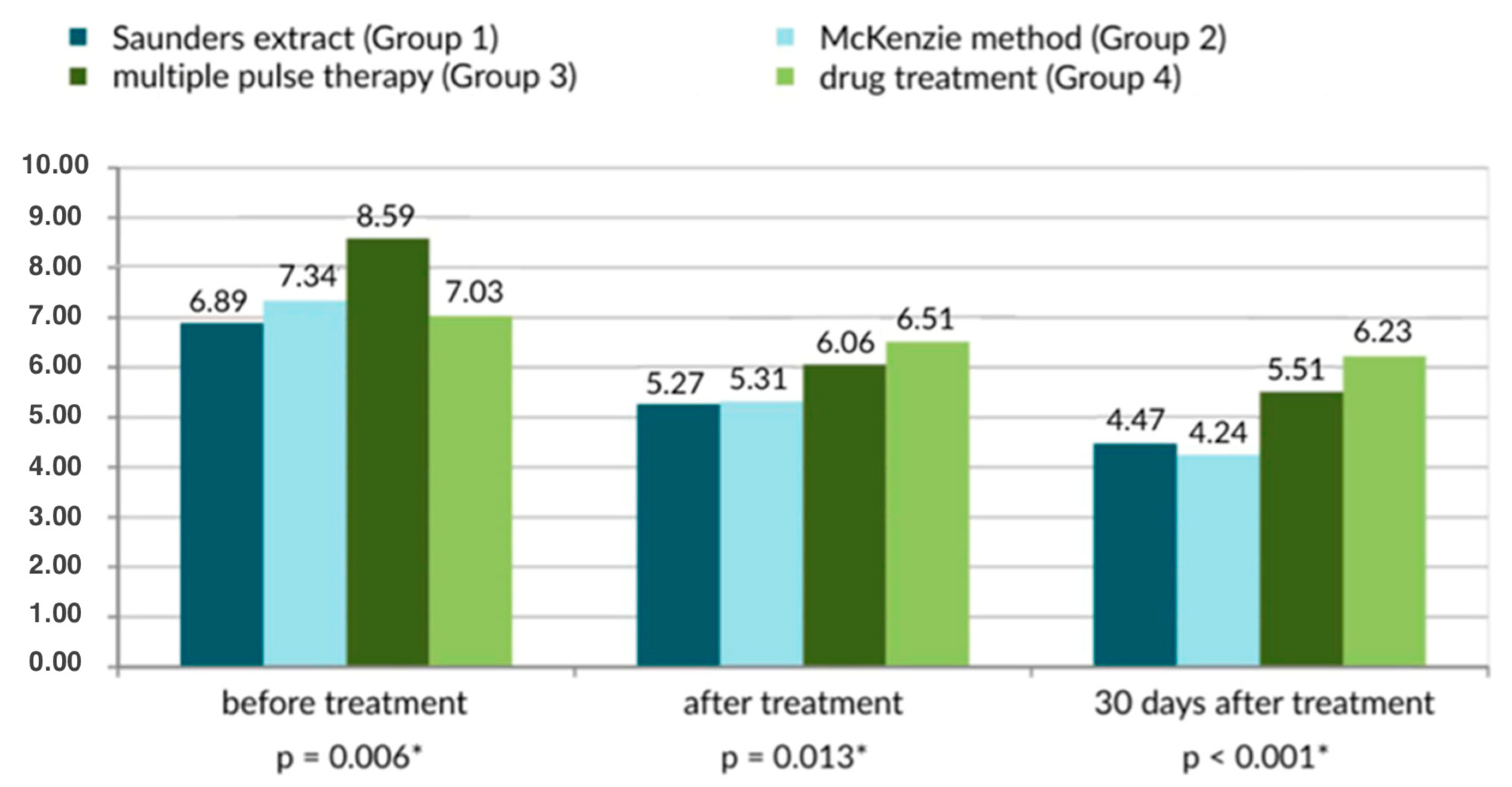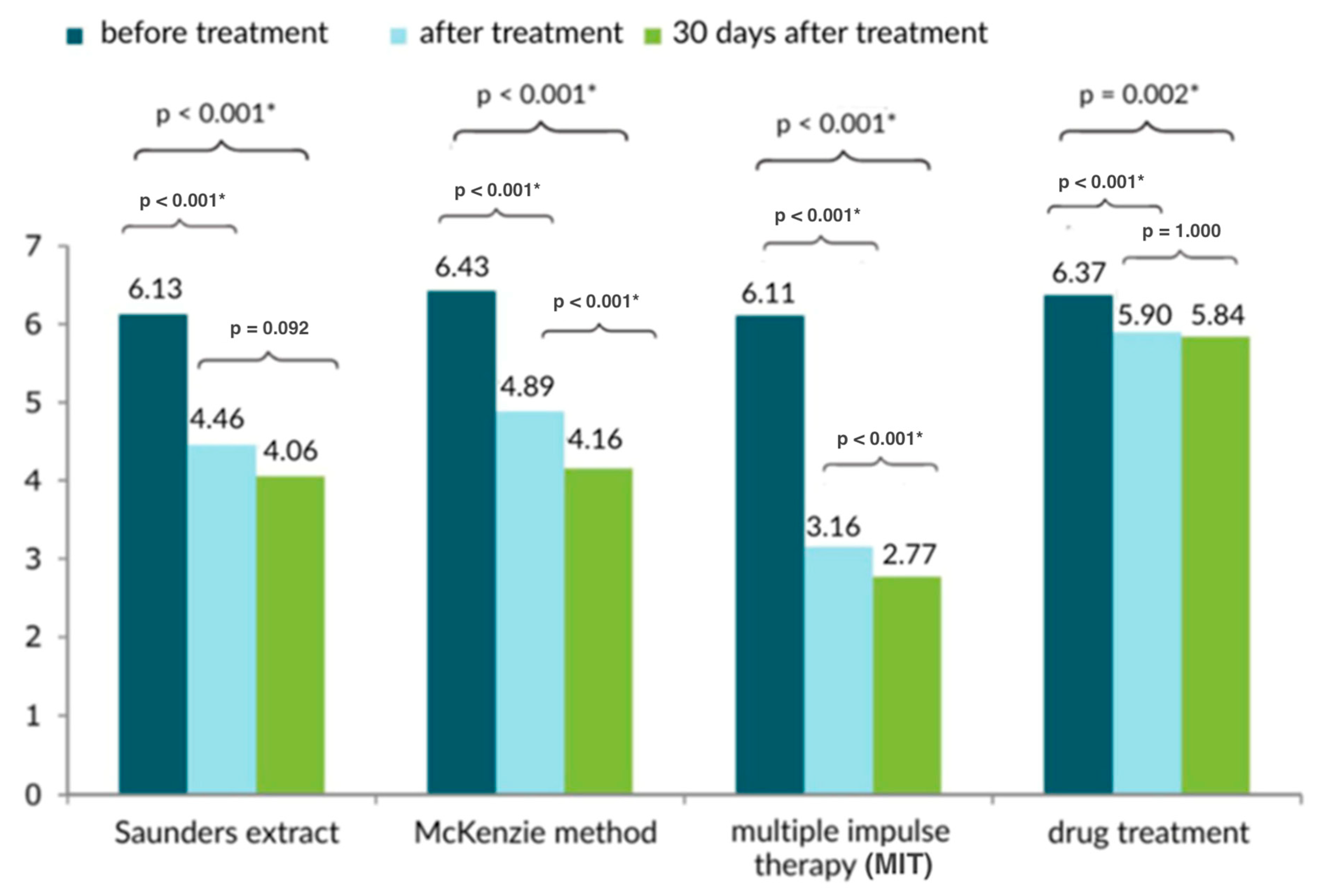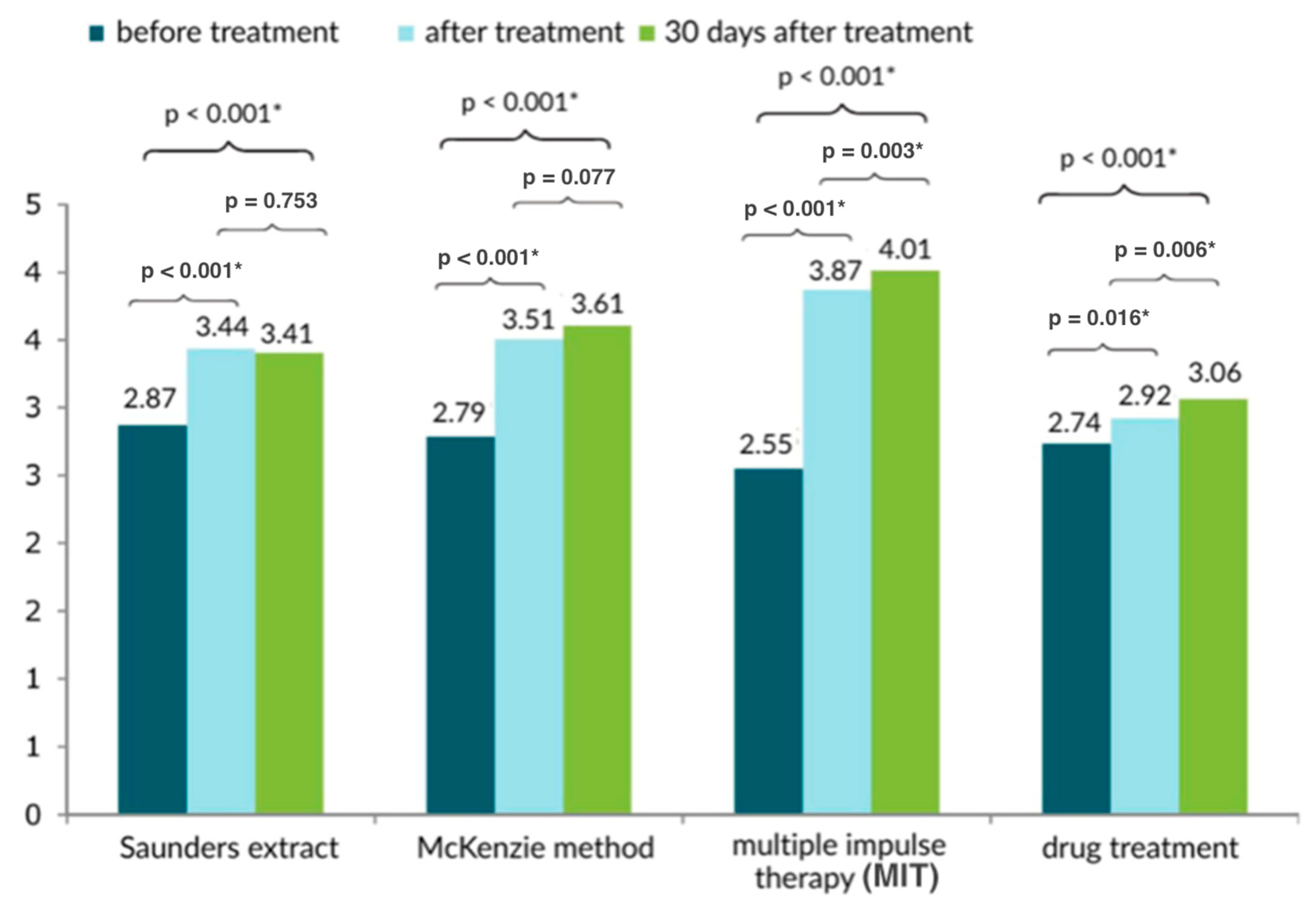A Comparison Between Physical Methods Based on Mechanical Action and Pharmacotherapy in the Treatment of Discogenic Low Back Pain
Abstract
1. Introduction
2. Materials and Methods
2.1. Inclusion Criteria
- -
- Informed consent to the treatments;
- -
- Chronic low back pain syndrome of discogenic origin, lasting at least 12 weeks;
- -
- Age between 30 and 60 years;
- -
- No contraindications to the method.
2.2. Exclusion Criteria
- -
- Tumors of the spinal cord, roots, and meninges, or primary and metastatic tumors of vertebral neoplasms;
- -
- Tuberculosis of the spine;
- -
- Fresh fractures;
- -
- Significant hypermobility of the spine;
- -
- Severe form of osteoporosis;
- -
- Individuals after spinal surgery.
2.3. Randomization
2.4. Statistical Analysis
3. Results
4. Discussion
5. Conclusions
Author Contributions
Funding
Institutional Review Board Statement
Informed Consent Statement
Data Availability Statement
Conflicts of Interest
References
- Koszela, K.; Krukowska, S.; Woldańska-Okońska, M. Back pain as a lifestyle disease. Paediatr. Fam. Med. 2017, 13, 344–351. [Google Scholar] [CrossRef]
- Tedeschi, R.; Giorgi, F.; Platano, D.; Berti, L. Classifying Low Back Pain Through Pain Mechanisms: A Scoping Review for Physiotherapy Practice. J. Clin. Med. 2025, 14, 412. [Google Scholar] [CrossRef]
- Pingot, J.; Pingot, M.; Łabecka, M.; Woldańska-Okońska, M. The use of Saunders lumbar traction in physiotherapy of patients with chronic lower back pain. Pol. Merkur. Lek. 2014, 36, 330–335. (In Polish) [Google Scholar]
- Haładaj, R.; Pingot, J.; Pingot, M. Assessment of rehabilitation progress in patients with cervical radicular pain syndrome after application of high intensity laser therapy—HILT and Saunders traction device. Pol. Merkur. Lek. 2015, 39, 23–30. (In Polish) [Google Scholar]
- Haładaj, R.; Topol, M. Multiple Impulse Therapy in the Assessment of Paraspinal Muscle Tone in Patients with Low Back Pain. Ortop. Traumatol. Rehabil. 2016, 18, 537–547. [Google Scholar] [CrossRef]
- Koszela, K.; Woldańska-Okońska, M. Age and Sex in Back Pain Intensity-Retrospective Study of Conservatory vs. Surgical Discopathy Treatment. Life 2022, 12, 1808. [Google Scholar] [CrossRef] [PubMed]
- Lewis, S.; Holmes, P.; Woby, S.; Hindle, J.; Fowler, N. The relationships between measures of stature recovery, muscle activity and psychological factors in patients with chronic low back pain. Man. Ther. 2012, 17, 27–33. [Google Scholar] [CrossRef]
- Evans, J.M.; Collins, D.L.; Leach, R.A. The Effect of Frequency of Treatment on Patient Response to Multiple Impulse Therapy for Low-Back Pain. J. Manip. Physiol. Ther. 2005, 28, 431–436. [Google Scholar]
- McKenzie, R.A.; May, S. The Human Extremities: Mechanical Diagnosis and Therapy; Spinal Publications: Waikanae, New Zealand, 2000; pp. 209–216. [Google Scholar]
- McKenzie, R.A.; May, S. The Lumbar Spine: Mechanical Diagnosis and Therapy, 2nd ed.; Spinal Publications: Waikanae, New Zealand, 2003; Volumes 1 and 2, pp. 9–163. [Google Scholar]
- Myśliwiec, A.; Saulicz, E.; Kuszewski, M.; Kokosz, M.; Wolny, T. Assesment of the influence of Saunders traction and transcutaneous electrical nerve stimulation on hand grip force in patients with neck pain. Ortop. Traumatol. Rehabil. 2011, 13, 37–44. [Google Scholar] [CrossRef]
- Yen, Y.R.; Luo, J.F.; Liu, M.L.; Lu, F.J.; Wang, S.R. The Anthropometric Measurement of Schober’s Test in Normal Taiwanese Population. Biomed. Res. Int. 2015, 2015, 256365. [Google Scholar] [CrossRef]
- Buckup, K.; Buckup, J. Klinische Tests en Knochen, Gelenken und Muskeln; Georg Thieme Verlag KG: Stuttgart, Germany, 2012; p. 6. [Google Scholar]
- George, S.Z.; Fritz, J.M.; Silfies, S.P.; Schneider, M.J.; Beneciuk, J.M.; Lentz, T.A.; Gilliam, J.R.; Hendren, S.; Norman, K.S. Interventions for the Management of Acute and Chronic Low Back Pain: Revision 2021. J. Orthop. Sports Phys. Ther. 2021, 51, CPG1–CPG60. [Google Scholar] [CrossRef]
- Gatterman, M.I. Whiplash: A Patient Centered Approach to Managemen, 1st ed.; Elsevier: Amsterdam, The Netherlands, 2011. [Google Scholar]
- Tsiarleston, G.; López-Fernández, M.D.; Pavón-Muñoz, R.; Aguilera-García, I.; López-Corchón, M.; Delgado-Fernández, M.; Castellote-Caballero, M.Y.; Donoso, B.; Mesa-Ruiz, A.M.; Pozuelo-Calvo, R.; et al. Multimodal intervention based on physical exercise, mindfulness, behaviour change and education to improve pain and health in patients with chronic primary low back pain: A study protocol of the HEALTHYBACK randomised controlled trial. BMJ Open Sport. Exerc. Med. 2024, 10, e002188. Erratum in BMJ Open Sport Exerc. Med. 2025, 11, e002188corr1. https://doi.org/10.1136/bmjsem-2024-002188corr1. [CrossRef]
- Karateev, A.; Polishchuk, E.; Fesyun, A.; Konchugova, T.; Filatova, E.; Amirdzhanova, V.; Kulchitskaya, D.; Potapova, A.; Sukhareva, M.; Lila, A.; et al. Magnetic therapy in acute and subacute non-specific back pain: Results of an open multicenter study. Eur. J. Transl. Myol. 2022, 32, 10686. [Google Scholar] [CrossRef]
- Koszela, K. A three-stage concept of spine pathology treatment—A different perspective. Reumatologia 2024, 62, 58–63. [Google Scholar] [CrossRef] [PubMed]
- Koszela, K.; Słupiński, M.; Woldańska-Okońska, M. The Role of Rehabilitation after Spinal Mesotherapy in a Three-Stage Treatment Concept. J. Clin. Med. 2024, 13, 3195. [Google Scholar] [CrossRef]
- Koszela, K.; Woldańska-Okońska, M.; Gasik, R. Efficacy and Safety of Spinal Collagen Mesotherapy in Patients with Chronic Low Back Pain in a Three-Month Follow-Up-Retrospective Study. J. Clin. Med. 2024, 13, 787. [Google Scholar] [CrossRef] [PubMed]
- Zdrodowska, B.; Leszczyńska-Filus, M.; Leszczyński, R.; Błaszczyk, J. Comparison of the effect of laser and magnetic therapy for pain level and the range of motion of the spine of people with osteoarthritis lower back. Pol. Merkur. Lek. 2015, 38, 26–31. (In Polish) [Google Scholar]
- Goode, A.P.; Cleveland, R.J.; Kraus, V.B.; Taylor, K.A.; George, S.Z.; Schwartz, T.A.; Renner, J.; Huebner, J.L.; Jordan, J.M.; Golightly, Y.M. Biomarkers and longitudinal changes in lumbar spine degeneration and low back pain: The Johnston County Osteoarthritis Project. Osteoarthr. Cartil. 2023, 31, 809–818. [Google Scholar] [CrossRef]
- Goode, A.P.; Carey, T.S.; Jordan, J.M. Low back pain and lumbar spine osteoarthritis: How are they related? Curr. Rheumatol. Rep. 2013, 15, 305. [Google Scholar] [CrossRef]
- Evans, J.M.; Collins, D.L.; Grundy, R.H. Pilot study of patient response to multiple impulse therapy for musculoskeletal complaints. J. Manip. Physiol. Ther. 2006, 29, 51.e1–51.e7. [Google Scholar] [CrossRef] [PubMed]
- Koszela, K.; Woldańska-Okońska, M. The effect of smoking on back pain intensity in rehabilitated patients treated conservatively and surgically for discopathy. Ann. Agric. Environ. Med. 2021, 28, 179–182. [Google Scholar] [CrossRef]
- Hsieh, D.; Chen, Y.C.; Chang, H.C.; Wei, C.C.; Lee, T.H. Efficacy of Electroacupuncture Compared to Standard and Manual Needling Therapy for Nonspecific Low Back Pain: A Systematic Review and Meta-Analysis. Cureus 2024, 16, e72577. [Google Scholar] [CrossRef]
- Kapil, D.; Wang, J.; Olawade, D.B.; Vanderbloemen, L. AI-Assisted Physiotherapy for Patients with Non-Specific Low Back Pain: A Systematic Review and Meta-Analysis. Appl. Sci. 2025, 15, 1532. [Google Scholar] [CrossRef]
- Hartmann, R.; Avermann, F.; Zalpour, C.; Griefahn, A. Impact of an AI app-based exercise program for people with low back pain compared to standard care: A longitudinal cohort-study. Health Sci. Rep. 2023, 6, e1060. [Google Scholar] [CrossRef]
- Do, K.; Kawana, E.; Vachirakorntong, B.; Do, J.; Seibel, R. The use of artificial intelligence in treating chronic back pain. Korean J. Pain 2023, 36, 478–480. [Google Scholar] [CrossRef] [PubMed]
- Schwab, F.; Mekhail, N.; Patel, K.V.; Langhorst, M.; Heros, R.D.; Gentile, J.; Costandi, S.; Moore, G.; Gilmore, C.; Manion, S.; et al. Restorative Neurostimulation Therapy Compared to Optimal Medical Management: A Randomized Evaluation (RESTORE) for the Treatment of Chronic Mechanical Low Back Pain due to Multifidus Dysfunction. Pain Ther. 2025, 14, 401–423. [Google Scholar] [CrossRef] [PubMed]
- Jain, K.; Rishi, P.; Aggarwal, A. Evidence Based Physiotherapy Intervention on Lumbar Instability: A Systematic Review. Musculoskelet. Care 2025, 23, e70132. [Google Scholar] [CrossRef] [PubMed]
- Tikhile, P.; Patil, D.S. Unveiling the Efficacy of Physiotherapy Strategies in Alleviating Low Back Pain: A Comprehensive Review of Interventions and Outcomes. Cureus 2024, 16, e56013. [Google Scholar] [CrossRef]






| Description | Patients Undergoing Treatment with Saunders Traction (Group 1) | Patients Undergoing McKenzie Treatment (Group 2) | Patients Undergoing Multiple Impulse Therapy (Group 3) | Patients Undergoing Pharmacological Treatment (Group 4) | Total | |
|---|---|---|---|---|---|---|
| Women | n | 35 | 36 | 32 | 31 | 134 |
| % | 50.0% | 51.4% | 45.7% | 44.3% | 47.9% | |
| Men | n | 35 | 34 | 38 | 39 | 146 |
| % | 50.0% | 48.6% | 54.3% | 55.7% | 52.1% | |
| Total | n | 70 | 70 | 70 | 70 | 280 |
| % | 100.0% | 100.0% | 100.0% | 100.0% | 100.0% | |
| Description | Patients Undergoing Treatment with Saunders Traction (Group 1) | Patients Undergoing McKenzie Treatment (Group 2) | Patients Undergoing Multiple Impulse Therapy (Group 3) | Patients Undergoing Pharmacological Treatment (Group 4) |
|---|---|---|---|---|
| Number of respondents | 70 | 70 | 70 | 70 |
| Average | 45.40 | 45.16 | 44.41 | 45.84 |
| 5% trimmed mean | 45.42 | 45.14 | 44.35 | 45.89 |
| Median | 45.00 | 44.00 | 43.00 | 47.00 |
| Standard deviation | 9.02 | 9.40 | 9.17 | 8.56 |
| Minimum | 30 | 30 | 30 | 30 |
| Maximum | 60 | 60 | 60 | 60 |
| Range | 30 | 30 | 30 | 30 |
| Coefficient of asymmetry | 0.101 | 0.142 | 0.148 | −0.109 |
| Kurtosis | −1.121 | −1.275 | −1.056 | −0.956 |
| Assessment of the significance of differences (ANOVA) | Levene’s test of homogeneity of variance: p = 0.662 ANOVA: p = 0.821 | |||
Disclaimer/Publisher’s Note: The statements, opinions and data contained in all publications are solely those of the individual author(s) and contributor(s) and not of MDPI and/or the editor(s). MDPI and/or the editor(s) disclaim responsibility for any injury to people or property resulting from any ideas, methods, instructions or products referred to in the content. |
© 2025 by the authors. Licensee MDPI, Basel, Switzerland. This article is an open access article distributed under the terms and conditions of the Creative Commons Attribution (CC BY) license (https://creativecommons.org/licenses/by/4.0/).
Share and Cite
Pingot, J.; Słupiński, M.; Lipski, A.; Woldańska-Okońska, M. A Comparison Between Physical Methods Based on Mechanical Action and Pharmacotherapy in the Treatment of Discogenic Low Back Pain. Healthcare 2025, 13, 2238. https://doi.org/10.3390/healthcare13172238
Pingot J, Słupiński M, Lipski A, Woldańska-Okońska M. A Comparison Between Physical Methods Based on Mechanical Action and Pharmacotherapy in the Treatment of Discogenic Low Back Pain. Healthcare. 2025; 13(17):2238. https://doi.org/10.3390/healthcare13172238
Chicago/Turabian StylePingot, Julia, Michał Słupiński, Adam Lipski, and Marta Woldańska-Okońska. 2025. "A Comparison Between Physical Methods Based on Mechanical Action and Pharmacotherapy in the Treatment of Discogenic Low Back Pain" Healthcare 13, no. 17: 2238. https://doi.org/10.3390/healthcare13172238
APA StylePingot, J., Słupiński, M., Lipski, A., & Woldańska-Okońska, M. (2025). A Comparison Between Physical Methods Based on Mechanical Action and Pharmacotherapy in the Treatment of Discogenic Low Back Pain. Healthcare, 13(17), 2238. https://doi.org/10.3390/healthcare13172238






